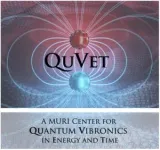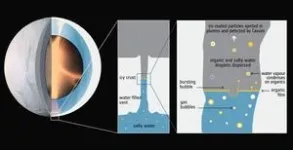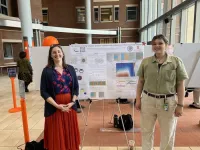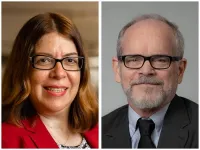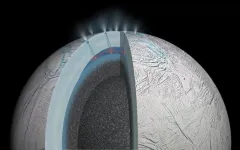(Press-News.org) RIVERSIDE, Calif. -- Physicist Nathaniel Gabor at the University of California, Riverside, has been awarded a $7.5M grant from the Department of Defense, or DoD, to develop a Multidisciplinary University Research Initiatives, or MURI, center on campus. Called QuVET for the Center for Quantum Vibronics in Energy and Time, the center’s co-principal investigators are leading scientists at UCR, Caltech, MIT, and Columbia University.
“Vibronic,” a portmanteau of vibrational and electronic, refers to transitions between molecular energy states. Vibronic behavior is central to both biological and material systems and could impact future technology’s energy harvesting efficiency. Vibronic effects — vibrational transitions that accompany electronic transitions — occur in systems ranging from photosynthetic light-harvesting antennae to molecular gases and solid-state materials.
Gabor, a professor of physics and astronomy and the five-year grant’s principal investigator, believes the strong partnership with DoD laboratories and industry will position QuVET to be a scientific and technological epicenter for quantum vibronics. He said the visionary science QuVet represents could place UCR at the head of a new era of science, where biology, physics, and chemistry are explored through the lens of quantum mechanics.
“This is science at its best, bringing a lot of positive attention to UCR,” said Shan-Wen Tsai, chair of the Department of Physics and Astronomy. “QuVet will open up many good research opportunities for our undergraduate and graduate students.”
In the following Q&A, Gabor, a leader in the fields of quantum materials and photosynthetic light harvesting research, discusses his vision for the new center he will direct. Vivek Aji, a professor of physics and astronomy at UCR and the grant’s co-principal investigator, also shares his thoughts.
Q: Specifically, what research will QuVet focus on?
Gabor: At the length scales of atoms and molecules, atomic vibrations can strongly affect the wave-like behavior (quantum nature) of electrons. When vibrations and electrons interact, the resulting behavior can only be described as vibronic. We have assembled a team of physicists, chemists, biochemists, and biologists to overcome three critical challenges in achieving new technologies that harness quantum mechanics:
(1) In many molecular and material systems, vibrations act to remove energy from electrons, decreasing the overall efficiency of energy transport. However, photosynthetic organisms have adapted to instead harness vibrations to enhance the efficient movement of energy. In new molecular and material systems, can we achieve the same outcome of photosynthesis in order to enhance transport towards ultimate efficiencies?
(2) Tuning the interaction between atomic motion and electronic states via experimental control remains impossible, prevented by scientists’ inability to engineer materials at the atomic scale. Can emerging biochemical strategies and novel materials enable direct control over the wave-like behavior of electronic and vibrational excitations?
(3) Design principles do not exist for next-generation quantum systems, which implement strong vibrational effects. How can we take inspiration from biology to develop new technologies based on exotic states in which vibrations directly affect electronic behavior?
Q: What will the collaboration with Caltech, MIT, and Columbia University scientists involve?
Aji: The QuVET team brings together leading researchers in disciplines ranging from quantum physics (UCR and Columbia) and quantum chemistry (Caltech and Columbia) to biophysics, biochemistry (MIT and UCR) and quantum materials (Columbia and UCR). Each member of the team brings unique expertise that strategically covers a broad scientific base. Since the center goals are ambitious and attempt to solve a major trans-disciplinary problem, it is important that each of the team members is a creative thinker and cross-disciplinary scientist.
Q: Why is now a good time for a center like this?
Gabor: The theoretical understanding and experimental control of vibronic behavior is complicated by the wide range of physical processes that also occur in complex systems, such as the molecular light harvesting antennae of photosynthesis, where vibronic effects play the most important roles. Indeed, a complete quantum treatment of vibronic effects does not exist.
Biology, physics, and chemistry converge at the atomic and molecular scale, where quantum mechanics becomes vastly more important than at large scales. As our research technologies have advanced — and we collectively study molecules and materials at smaller and smaller length scales — more and more studies point to quantum mechanics as a means to understand emerging behaviors. Recently, it was discovered that the vibrational motion of atoms plays a critical role not only in the remarkably high efficiency of photosynthetic organisms, but also the efficiency of energy transfer in electronic materials. Our projects are among the first to explore the ability to engineer the interaction between vibrational motion and electronic states, heralding a new era of quantum science.
We believe quantum vibronics will have a major impact on fundamental science and technology involving both the biology/biochemistry of quantum processes in light-sensing and the understanding of novel optoelectronic properties in quantum materials — two fields at the forefront of basic research within the DoD.
Q: What sets this center apart from other centers like it elsewhere?
Aji: Currently, no other center focuses strongly on vibronic effects and the possible future technologies that would result from a deep understanding of quantum vibronic phenomena.
QuVET takes such a strong multidisciplinary approach to the challenges we have described here. Vibronic effects occur in many places in nature and understanding them fully requires a very special combination of people and expertise.
Q: What do you hope this center will achieve?
Gabor: I hope this center marks a pivot towards trans-disciplinary science at UCR. With resources that are committed wisely, UCR could be the leader in emerging topics where quantum mechanics describes the interface between physics, chemistry, biology, and engineering.
Further, QuVET provides both undergraduate and graduate students with a unique opportunity to enter a fast-growing field — bio-inspired quantum vibronics — at its very outset and to steer its growth. The tightly integrated nature of the tasks will facilitate sharing of knowledge and resources between groups. Together with the strong collaborative ties between UCR, Caltech, Columbia, and MIT, this will create a multidisciplinary learning environment for students, fostering the development of young scientists with a unique blend of theoretical, materials and advanced spectroscopy expertise.
The University of California, Riverside is a doctoral research university, a living laboratory for groundbreaking exploration of issues critical to Inland Southern California, the state and communities around the world. Reflecting California's diverse culture, UCR's enrollment is more than 26,000 students. The campus opened a medical school in 2013 and has reached the heart of the Coachella Valley by way of the UCR Palm Desert Center. The campus has an annual impact of more than $2.7 billion on the U.S. economy. To learn more, visit www.ucr.edu.
END
New center positions UC Riverside as a leader in quantum vibronics
QuVet is funded by a $7.5 million grant from the Department of Defense
2024-03-22
ELSE PRESS RELEASES FROM THIS DATE:
MSU offers first study on teacher effectiveness for students with and without disabilities
2024-03-22
MSU has a satellite uplink/LTN TV studio and Comrex line for radio interviews upon request.
EAST LANSING, Mich. – Research has often focused on how teachers and educators can best instruct and accommodate students with disabilities. However, are the methods used to teach students with disabilities effective and inclusive for all students? Michigan State University researchers are some of the first to answer that question.
Faculty and doctoral students from across MSU, including from the College of Social Science and the College of ...
Molecular & Cellular Proteomics names new editor-in-chief
2024-03-22
The American Society for Biochemistry and Molecular Biology announced today that Ileana Cristea, professor of molecular biology and director of graduate studies at Princeton University, will be the next editor-in-chief of Molecular & Cellular Proteomics, one of the society’s three open-access, peer-reviewed journals. Cristea’s five-year term will begin Aug. 12.
Cristea has a long relationship with the journal. She has been a member of the editorial board since 2011, and she served as the editor for the MCP special issue, “Proteomics in Infectious Disease” in 2017.
Her research lies ...
DayCent-CABBI: new model integrates soil microbes, large perennial grasses
2024-03-22
Of all the carbon stored in ecosystems around the world, about half can be found in soils. Depending on climate, vegetation, and management, soils can be either a carbon source or a sink.
Natural climate solutions (NCS) offer a promising opportunity to bring us closer to our net-zero emissions goals by removing carbon dioxide from the atmosphere and storing it in plant biomass and soil. The growth of bioenergy feedstocks has great potential in this regard, because these grasses both build soil carbon and have the potential to be used to produce carbon-neutral biofuels and bioproducts.
Over ...
Maple syrup producers provide sweet news for threatened birds
2024-03-22
The summer mating season is looking to get a lot easier for the scarlet tanager, one of a number of migratory songbirds that use the forests of northeastern North America to find a mate.
In recent decades, the loss and degradation of bird habitats has led to a precipitous decline in bird populations. Now, a $2 million grant awarded to the National Audubon Society’s Bird-Friendly Maple program, in partnership with College of Natural Resources and Environment Associate Professor Ashley Dayer, will look to improve bird habitats by encouraging maple syrup producers to incorporate forest management practices that allow other ...
Neighborhood-level poverty and food insecurity during pregnancy associated with lower birthweight and small for gestational age infants, NIH study finds
2024-03-22
Living in neighborhoods where residents have lower incomes and limited food access during pregnancy was associated with an increased risk of babies born small for gestational age or with lower birthweight, according to a new study from the NIH Environmental Influences on Child Health Outcomes (ECHO) Program.
Previous studies have shown that maternal diet during pregnancy can impact the physical and mental health of a mother. However, less is known about how food insecurity affects health outcomes for newborns. In a new research article, ECHO researchers analyzed data to understand what connections might exist between where a pregnant ...
Using physics principles to understand how cells self-sort in development
2024-03-22
Erin McCarthy ’23, physics summa cum laude, is a rarity among young scientists. As an undergraduate researcher in Syracuse University's College of Arts & Sciences’ Department of Physics, she guided a study that appeared in March 2024 in Physical Review Letters. It is the most-cited physics letters journal and the eighth-most cited journal in science overall.
McCarthy and postdoctoral associates Raj Kumar Manna and Ojan Damavandi developed a model that identified an unexpected collective ...
SFU Publishing Director Hannah McGregor's new book asks "Can podcasting save academia?"
2024-03-22
A new book from Lori Beckstead, Ian M. Cook, and SFU Publishing Director Hannah McGregor, explores how the growth of scholarly podcasting may engender radical possibilities for how we conceive of knowledge creation and peer review, and the transformative potential of new modes of creating and reviewing expert knowledge.
"Podcast Or Perish" investigates the historical development of the norms of scholarly communication and asks how podcasting might change how we think about scholarly work. Could this be the call to action academia needs?
Read ...
Early intervention after the first seizure may prevent long-term epilepsy and associated cognitive deficits
2024-03-22
PHILADELPHIA— Only a very small percentage of neurons show changes after an epileptic seizure in mice, but these alterations can be permanent and trigger future seizures that can affect the whole brain and lead to impaired cognition, like memory and learning, according to new research from the Perelman School of Medicine at the University of Pennsylvania. The researchers identified an experimental treatment that, if provided within the first 48 hours after the first seizure, can prevent these long-term changes. The findings, which were published recently in The ...
Key appointments to advance technology, entrepreneurship and innovation at the University of Houston
2024-03-22
The University of Houston is proud to announce the appointment of two distinguished professionals to key leadership roles within the Office of Technology, Transfer, and Innovation (OTTI) under the Division of Energy and Innovation. These appointments mark a significant step forward in the University's continued commitment to fostering entrepreneurship, innovation and partnerships between academia and industry.
Haleh Ardebili, the Kamel Salama Endowed Professor of Mechanical Engineering, has been appointed as the new assistant vice president of Entrepreneurship and Startup Ecosystem. Michael Harold, ...
Signs of life detectable in single ice grain emitted from extraterrestrial moons
2024-03-22
The ice-encrusted oceans of some of the moons orbiting Saturn and Jupiter are leading candidates in the search for extraterrestrial life. A new lab-based study led by the University of Washington in Seattle and the Freie Universität Berlin shows that individual ice grains ejected from these planetary bodies may contain enough material for instruments headed there in the fall to detect signs of life, if such life exists.
“For the first time we have shown that even a tiny fraction of cellular material could be identified by a mass spectrometer onboard a spacecraft,” said lead author Fabian Klenner, a UW postdoctoral researcher in Earth and space sciences. ...
LAST 30 PRESS RELEASES:
World-first discovery uncovers how glioblastoma tumours dodge chemotherapy, potentially opening the door to new treatments
A fatal mix-up: How certain gut bacteria drive multiple sclerosis
New AI tool identifies not just genetic mutations, but the diseases they may cause
Deep-learning model predicts how fruit flies form, cell by cell
Combination pills for high blood pressure may simplify treatment, improve long-term health
Immune system keeps mucosal fungi in check
Neurons within the brain use simple rules to localize genetic messages
Electrodes created using light
Second-hand gift-giving is a well-deliberated decision
How human interaction drove evolution to make bears less aggressive
National Poll: Few parents offer teens guidance on healthy eating during holiday season
Cannabis derivatives could provide new ovarian cancer treatments
Raising strong yeast as a petroleum substitute
Clues to the origin of hot Jupiters hidden in their orbits
Canada’s reduced pledge to Global Fund will impact domestic health
1 in 4 children with major traumatic injuries not cared for in pediatric trauma centres
Duke and Duke-NUS’ joint cross-population research to uncover "East-West" differences in disease and care
Scientists to ‘spy’ on cancer- immune cell interactions using quantum technology breakthrough
Tech savvy users have most digital concerns
Making lighter work of calculating fluid and heat flow
Normalizing blood sugar can halve heart attack risk
Lowering blood sugar cuts heart attack risk in people with prediabetes
Study links genetic variants to risk of blinding eye disease in premature infants
Non-opioid ‘pain sponge’ therapy halts cartilage degeneration and relieves chronic pain
AI can pick up cultural values by mimicking how kids learn
China’s ecological redlines offer fast track to 30 x 30 global conservation goal
Invisible indoor threats: emerging household contaminants and their growing risks to human health
Adding antibody treatment to chemo boosts outcomes for children with rare cancer
Germline pathogenic variants among women without a history of breast cancer
Tanning beds triple melanoma risk, potentially causing broad DNA damage
[Press-News.org] New center positions UC Riverside as a leader in quantum vibronicsQuVet is funded by a $7.5 million grant from the Department of Defense

